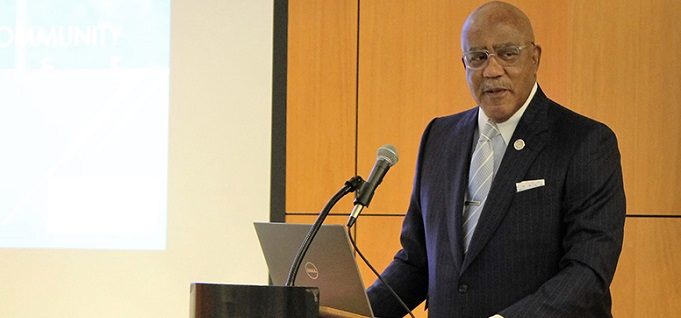Cultivating diverse leaders
By Matthew Dembicki
December 12, 2018
As community colleges look to fill the leadership pipeline, there’s an opportunity to ensure emerging leaders represent the diversity of their students.
Community colleges are looking for a few good men — and women, and people of color and any well-qualified leader looking for a robust career in higher education.
That was the message Walter Bumphus, president and CEO of the American Association of Community Colleges (AACC), conveyed at a meeting of college and university chief diversity officers in Washington, D.C., on Wednesday.
As community colleges look to develop a pipeline for retiring baby boomer leaders — the sector sees some 250 turnovers annually among its presidents — there is an opportunity to ensure emerging leaders represent the diversity of their students, Bumphus said.
Community colleges already are in the forefront of higher education in hiring women and people of color for leadership positions, especially presidents, he said. For example, women represent the fastest-growing population among community college CEOs, comprising more than one-third of those positions.
Bumphus highlighted various efforts to increase diversity among leaders. He noted that Minnesota is a leader among states that have hired the most community college presidents of color. State system officials ensured that the pool of candidates included qualified diverse leaders, he said. And that started with making sure the search committees themselves were diverse.
Public two-year colleges are also starting to look outside the traditional pipeline for leaders, Bumphus said. He noted AACC next year will hold a professional development event on nontraditional pathways that can lead to the community college presidency, which may interest K-12 superintendents, those who have served in the military, university officials and others.
Opportunities through AACC
AACC continues to offer professional development for emerging leaders, new college presidents and seasoned CEOs through programs in its leadership suite. It also just released a new edition of its popular leadership competencies that serve as a guide for community college presidents, mid-level managers and faculty, too.
“At every stage in my career, I have always tried to up my leadership game,” Bumphus said at the meeting. “We try to provide such an opportunity for others to do the same using this document.”
The association listens closely to its members and uses that to develop its programming. For example, Bumphus meets with new college presidents at AACC’s annual convention to find out what they wish they knew before they become CEOs. Topics on that list include fundraising, budgets, legislative issues, public relations and the politics of the job.
Lessons learned
The AACC president also provided attendees a list of 10 lessons he’s learned over 30 years in teaching and leading. The list includes:
- Know who you are as a leader and a person.
- Hire great people and support professional development.
- Develop your system of communication.
- Inspect what you expect.
- Continually tweak and refine your vision, coupled with precise execution.
- Minimize your number of enemies; develop, nurture and respect relationships.
- Never let them see you sweat and have an unrelenting work ethic — getting the position is just the beginning.
- Develop a passion for what you do.
- Determine what makes your talents and skills unique.
- Keep a balanced life, have fun and don’t stay too long.
Bumphus explained each point and how they tied into leadership. For example, changing one’s mind is OK. He noted that it wasn’t so long along that the prevalent thought was that community college students “had a right to fail,” meaning it was up to them to determine which classes to take and ensure their success. Today, efforts like AACC’s Pathways initiative help students focus on a program of study and provide services such as counseling to guide them toward success.
Bumphus also expanded on what he means by “inspect what you expect.” As a college leader, it’s advisable to check with your team to ensure things are running smoothly. Don’t micromanage, but do understand how things work.
“You don’t want to get in the weeds, but know what’s in the weeds,” Bumphus said.
There’s more to the story! Read the full article in CC Daily.



